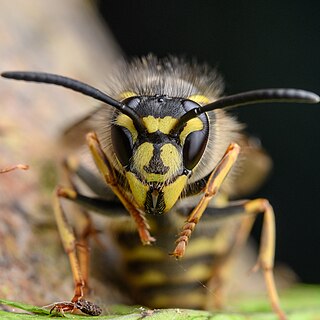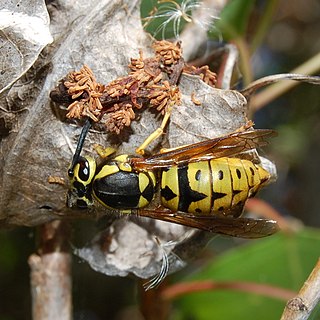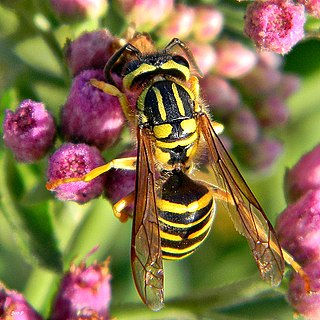
Yellowjacket or yellow jacket is the common name in North America for predatory social wasps of the genera Vespula and Dolichovespula. Members of these genera are known simply as "wasps" in other English-speaking countries. Most of these are black and yellow like the eastern yellowjacket Vespula maculifrons and the aerial yellowjacket Dolichovespula arenaria; some are black and white like the bald-faced hornet, Dolichovespula maculata. Others may have the abdomen background color red instead of black. They can be identified by their distinctive markings, their occurrence only in colonies, and a characteristic, rapid, side-to-side flight pattern prior to landing. All females are capable of stinging. Yellowjackets are important predators of pest insects.

The bald-faced hornet is a eusocial wasp of the cosmopolitan family Vespidae. It is also known as the bald hornet, white-faced hornet, black jack, white-tailed hornet, white-ass hornet, spruce wasp, blackjacket, and bull wasp. This species is a yellowjacket wasp, not a true hornet. Colonies contain 400 to 700 workers, the largest recorded colony size in its genus, Dolichovespula. It builds a characteristic large hanging paper nest up to 58 centimeters (23 in) in length. Workers aggressively defend their nest by repeatedly stinging invaders.

The median wasp is a species of social wasp of the family Vespidae found throughout Europe and Asia. It builds aerial paper nests often in shrubs or trees, and occasionally under the eaves of buildings. It is most common to see this wasp between May and October during its 3.3 month colony cycle. Behaviours of this wasp include nest defense, curling which is believed to function in brood incubation, and gastral vibration which is involved in larval feeding. The median wasp has a halplodiploid sex determination system that results in a high level of relatedness within the colony. This species is not usually aggressive but will sting if they feel their nest is threatened. Most foraging in the nest is done by the workers once the first ones reach adulthood. These workers forage for insects, nectar, and wood for nest construction in temperatures as low as 7 °C (45 °F). The median wasp is known to be occasionally affected by the fungus Cordyceps sphecocephala and the Cricket paralysis virus.

Vespula vulgaris, known as the common wasp, is found in regions that include the United Kingdom, Germany, India, China, New Zealand and Australia. It is sometimes known as the European wasp, but the same name is used for the species Vespula germanica or German wasp. Another name for Vespula vulgaris is the common yellow-jacket. In 2010, the ostensible Vespula vulgaris wasps in North America were found to be a different species, Vespula alascensis.

Vespula pensylvanica, the western yellowjacket, is a Nearctic species of wasp in the genus Vespula. It is native to regions of North America, largely in areas with northern temperate climates. Its reproductive behavior is constrained by cold weather, which successfully reduces the number of western yellowjackets in cold months. However, in the absence of cold weather, this wasp's population can explode. The western yellowjacket has become particularly invasive in the Hawaiian Islands, resulting in their label as a major pest.

The eastern yellow jacket or eastern yellowjacket is a wasp found in eastern North America. Although most of their nests are subterranean, they are often considered a pest due to their nesting in recreational areas and buildings. This yellow jacket is a social insect, living in colonies of hundreds to thousands of individuals. Along with their subfamily, Vespinae, this species demonstrates supportive parental care for offspring, separation of reproductive and sterile castes, and overlapping generations. They aggressively defend their hives from threats and are known to inflict painful stings.

Polistes chinensis is a polistine vespid wasp in the cosmopolitan genus Polistes, and is commonly known as the Asian, Chinese or Japanese paper wasp. It is found in East Asia, in particular China and Japan. The subspecies P. chinensis antennalis is an invasive species in New Zealand, having arrived in 1979.

Dolichovespula saxonica, also known as the Saxon wasp, is a common social wasp found in the palearctic region, specifically in large parts of Europe and in northern and central Asia. Although originally from continental Europe, D. saxonica has since colonised Britain, mainly in the south and east, but has been recorded as far north as East Lothian, Scotland. Most of their nests are above ground in trees and bushes, but they can also be found in buildings. Due to the proliferation of nests in urban areas and near residential homes, D. saxonica can be a pest for people. As a result, many human interventions are in place to remove Saxon nests. D. saxonica has been found to use chemical signaling in a lot of behaviours, such as alarm calls, fertility cues, and chemical trails.

The Norwegian wasp is a species of eusocial wasp. It is common in Scandinavia and can also be found in Scotland and other areas in Britain and Ireland. Often known for being a tree wasp, it nests in low branches and bushes and feeds on insects. It also obtains nectar from blueberry and snowberry flowers. Although Dolichovespula norwegica were rarely considered as pests in the past, a few cases of pest problems relating to D. norwegica have been reported multiple times. The species is not endangered.

Dolichovespula adulterina is a species of parasitic social wasp. D. adulterina lives in the Palearctic and Nearctic regions but parasitise different host species depending on which region it inhabits. D. adulterina feeds on a variety of foods including insects, spiders, arthropods, meat, molluscs, fruit, nectar and larval secretions. D. adulterina is synonymous with D. arctica from the Palearctic region.

Vespula rufa, commonly known as the red wasp, is a social wasp species belonging to the genus Vespula. It is found in northern and central Europe, parts of Asia, and northern parts of North America. Vespula rufa is characterised by red-brown markings and body segmentation, with the appearance varying amongst the different roles of individuals in the species. These wasps build small nests in dry banks underground that are not far below the surface. The colony cycle begins in the fall. Vespula rufa feed on live insects. One interesting fact about Vespula rufa is that the queen policing occurs in the species, and that worker policing occurs at much lower rates than other species in the genus Vespula. There are predators and parasites of the species. The species goes through a series of events before leaving the nest.

Vespula squamosa, the southern yellowjacket, is a social wasp. This species can be identified by its distinctive black and yellow patterning and orange queen. These yellowjackets are typically found in eastern North America, and its territory extends as far south as Central America. Within these territories, they create enormous, multiple-comb nests. The colonies may be either annual or perennial depending on the climate, and in many perennial nests, polygyny takes place. In addition, this species uses pheromones both as a sexual attractant and an alarm signal. This species feeds on insects and animal carcasses; it does not produce honey. V. squamosa, a social insect, has developed a parasitic relationship with the species V. vidua and V. maculifrons. Due to their painful, venomous stings, the species is considered a pest.

Dolichovespula arenaria, also known as the common aerial yellowjacket, sandhills hornet, and common yellow hornet, is a species of wasp within the Dolichovespula genus widely distributed in the North American continent.

Polybia occidentalis, commonly known as camoati, is a swarm-founding advanced eusocial wasp. Swarm-founding means that a swarm of these wasps find a nesting site and build the nest together. This species can be found in Central and South America. P. occidentalis preys on nectar, insects, and carbohydrate sources, while birds and ants prey on and parasitize them. P. occidentalis workers bite each other to communicate the time to start working.

Polistes biglumis is a species of social wasp within Polistes, the most common genus of paper wasp. It is distinguished mainly by its tendency to reside in montane climates in meadows or alpine areas. Selection pressure from the wasp's environment has led to several idiosyncrasies of its behavior and life cycle with respect to its relative species in the genus Polistes. It alone among paper wasps is often polyandrous. In addition, it has a truncated nesting season that gives rise to unique competitive dynamics among females of the species. P. biglumis wasps utilize an odor based recognition system that is the basis for all wasp to wasp interaction of the species. The wasp's life cycle is highly intertwined with that of Polistes atrimandibularis, an obligate social parasite wasp that frequently invades the combs of P. biglumis wasps.

Vespula atropilosa, also known as the prairie yellowjacket, is a black and yellow social wasp that forms annual colonies. Vespula atropilosa was formerly a member of the Vespa family. Males have either xanthic (yellow) or melanic (black) abdominal coloring. The prairie yellowjacket can be found in the Western and Midwestern United States as well as parts of southern Canada. It builds its nests underground and prefers large open areas such as pastures and golf courses. Vespula atropilosa colonies are founded by a queen in the spring and grow most during mid-summer. It preys on other insects such as flies and grasshoppers but is not a scavenger like other wasps. Queens mate with multiple males, and males will fight each other for matings. V. atropilosa is a social wasp that practices altruism. Prairie yellowjackets are not considered pests but are commonly found in backyards in the Pacific Northwest. This species derives its common name from the prairies and grasslands where it can be found.
Protopolybia exigua is a species of vespid wasp found in South America and Southern Brazil. These neotropical wasps, of the tribe Epiponini, form large colonies with multiple queens per colony. P. exigua are small wasps that find nourishment from nectar and prey on arthropods. Their nests are disc-shaped and hang from the undersides of leaves and tree branches. This particular species of wasp can be hard to study because they frequently abandon their nests. P. exigua continuously seek refuge from phorid fly attacks and thus often flee infested nests to build new ones. The wasps' most common predators are ants and the parasitoid phorid flies from the Phoridae family.

Polybia sericea is a social, tropical wasp of the family Vespidae that can be found in South America. It founds its colonies by swarming migrations, and feeds on nectar and arthropods.

Mischocyttarus flavitarsis is a social paper wasp found in western North America. Their nests can be found both in forests close to rivers or in close proximity to human life under the eaves of roofs. Despite the fact that M. flavitarsis nests are frequently in close contact with humans, M. flavitarsis typically will not sting, but rather ram into the threatening individual. Their colony cycle typically begins before May and will last until October. The queen will then seek a hibernation site for the winter. Perched near female hibernation sites are males with whom the female will mate. The males have claimed their territory by rubbing sternal brushes along the border of the site, leaving a chemical that deters other individuals from approaching. M. flavitarsis feed on arthropods, nectar, and animal carcasses and are often prey to birds, ants, and praying mantis.

Polistes versicolor is a subtropical social wasp within Polistes, the most common genus of paper wasp. The most widely distributed South American wasp species, P. versicolor is particularly common in the Southeastern Brazilian states. This social wasp is commonly referred to as the yellow paper wasp due to the distinct yellow bands found on its thorax and abdomen. The P. versicolor nest, made of chewed vegetable fiber, is typically a single, uncovered comb attached to the substratum by a single petiole. The yellow wasp is frequently found in urban areas. New nests and colonies are usually founded by an association of females, sometimes in human buildings. The P. versicolor colony cycle broadly ranges from 3 to 10 months, although there appears to be no relationship between the colony's development and the season of the year. While yellow paper wasps do have clear annual colony cycles, many young queens have the opportunity to hibernate during the winter, forming optional winter aggregations. Dominance hierarchies within these aggregations are characterized by physical aggression of the dominant female(s) towards the associated females, who tend to be sisters. Wagging movements are also often used as a form of communication within the colony. The yellow paper wasp is generally predatory, capturing a wide range of insects, although it often feeds on pollen and nectar as well. Therefore, P. versicolor can be useful as a pollinator or as effective pest control.























